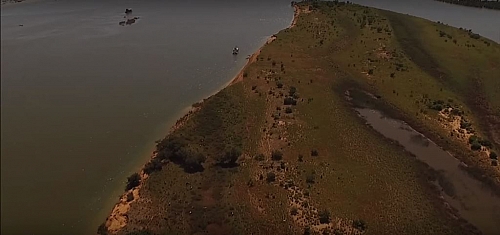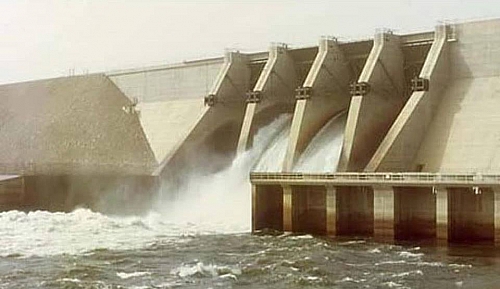Table of Contents
History and Spatial Extent of Niger River
River Niger is a famous River in Nigeria; it is located in Niger State, its name comes from the Latin word niger, which means “black”. The native-born population call River Niger with different names such as ‘Jeliba’ or ‘Joliba’ in Manding dialect which means ‘great river’. It is called ‘Orimiri’ or ‘Orimili’ in Igbo language, which means ‘great water’.’Egerew n-Igerewen’ in Tuareg dialect which means river of rivers. ‘Isa Ber’ in Songhay dialect which means ‘big river’. Kwara, in Hausa dialect and lastly it is called Oya in Yoruba dialect. However, Nigeria and Niger got their names from the River Niger, thus it is commonly called; The Niger River; or River Niger which all mean the same thing. This River provides both domestic and economic values to Nigeria and the neighbouring countries.
Spatial Extent
River Niger is the longest river in Nigeria; it covers an area of about 4,180km (2600 miles). The River rises on the Fouta Djallon Plateau, SW Guinea, flowing NE through Guinea into Mali and Niger before entering Nigeria through Lokoja, where it forms parts of its borders with Benin before emptying into the Gulf of Guinea in the Atlantic Ocean through the Niger Delta.
River Niger is the first longest River in West Africa, after River Nile and Congo; it is the third longest in the continent of Africa and the 11th longest River in the World. This river gets its source from the Guinea Highlands, while its main tributaries are from Kaduna River, Sokoto River, Bani River and Benue River. The volume of the River does not remain the same throughout year as it fluctuates from time to time. The discovery and exploitation of petroleum in the Niger Delta region has in so many ways affected the turbidity and the activities of the River; the Niger River has become more polluted as it flows along its route to the Atlantic Ocean; this however, has seriously disrupted fishing there. Other factors such as increased water abstraction for irrigation farming and seasonal fluctuation (Climate change) have largely affected the volume and flow of the Niger River.
How Does River Niger Flow?
The River Niger flows in an unusual directions;its flow is unusual because its source is just 240km (150miles) from theAtlantic Ocean. The Niger instead of flowing directly into the nearby Atlantic Ocean, the River rather flow directly away from the sea intoSahara desert, then takes a sharp right turn near the ancient city ofTimbuktu (Tombouctou) and heads southeast to the Gulf of Guinea. This unusual flow is as a result of the two ancient Rivers that join The Niger river together.
Who first discovered River Niger?
The River Niger was discovered in 1796 by a Scottish explorer named Mungo Park . Mungo Park was the first European to step his foot on the middle part of Niger River; He sailed 1,500 miles through the central section of the River. The true course was established in his bookTravels in the Interior of Africa,which appeared in 1799; Mungo Park died in 1806, he was drowned in some rapids while fleeing hostile from native tribesmen.
Niger River Facts (Geography of Niger River)
- Niger River flows from eastern Guinea and travels northeast, away from the coast, into Mali and the Sahara Desert. Here the river drains into an unusual inland delta, which provides an important area of bogs, marshes and lakes in the middle of the dry land (Sahara desert).
- The Niger River is 10 times clearer than the Nile River because its source (Guinea Highlands)lie in ancient rocks that provide little silt.
- Like any other river in Africa, the Niger River experiences annual flood, the flooding begins in September and ends by May, the Kainji Dam apart from being used to generate electricity, it is also important for controlling flood in this region.
- An important tributary of the Niger River Nigeria is theBenue River, which covers an area of 1400km (870 miles long).
- The River Niger loses nearly two-thirds of its potential flow due to a decrease in gradient in the Inner Delta betweenSgouandTimbuktuto seepage and evaporation; with all the flows coming from theBani River into the Delta atMopti, it is still not enough to compensate for the ‘losses’.
- River Niger is a Fresh water ecosystem; it is a home to 36 families of freshwater fish and nearly 250 species, of which 20 of these species are not found anywhere else on Earth, but the Niger River.
- Many other species of fauna such as geese, herons, egret, sandpipers,curlews,pelicans and flamingos are found in the lake region and on the River bank.
- The Niger River like any other River floods each year; during the flooding, it deposits nutrient-rich silt on the bank to enable the growth of crops like rice, millet and sorghum. These crops in turn provide food to the inhabitants of Niger State and other regions in Nigeria.
- The Rivers Niger and Benue meet at Lokoja in Kogi state, forming a Y-shaped structure in what appears to be a magnificent union and draining southwards into the Ocean. The point where these two Rivers meet is called a confluence.
- Some significant dams have been constructed for purpose of generating electricity on the Niger River. One of the largest is the Kainji Dam at New Bussa. This dam was built both to protect against flooding and for generating hydroelectric power. Other dams include the Sotuba and dam in Mali, Markala dam at Jebba (on the Niger) and Shiroro (on the Kaduna tributary) in Nigeria.
Economic Importance of River Niger
- River Niger provides water for irrigation farming during dry season, especially for the inhabitants living near the River; the inhabitant of Niger State solely depend on this water supply to irrigate their crops.
- The point where the two main Rivers (River Niger and Benue) meet to form a confluence provides the needed volume and speed to power the energy for the generation of hydroelectric power stations. This energy serves Nigeria and other neighbouring countries hence, contributing to the economy of Nigeria.
- Major river such as Niger River, offer a source of livelihood to the Niger State through fishing and selling of surplus fish to the market.
- Niger River serves as a home to different water creatures such as the African Lion, African manatee (sea cow), catfish, carp, Nile perch, hippopotamuses and crocodiles among other animals.
- Large-scale farming takes place at the bank of River Niger; most of these crops are sold within the country, while majority of these are exported to other countries.
- River Niger helps provide job opportunity for sailor and local fishermen, as the water is deep enough for different species of fish.
- The River serves as the main source of water for domestic and industrial uses in Niger State, mostly after it has been purified.
- River Niger has a significant length and depth, which makes it possible for navigation; it is often used for commercial shipping- for transporting heavy goods from the Atlantic Ocean to Onitsha throughout the year.
- The Niger River has enough deposits of sand, both the Sandmud are usually removed from the bottom of the river for construction of roads and houses.
10 Major Rivers in Nigeria listed according to rank and length
Rank |
Rivers |
Length |
1. |
Niger River |
2600 miles long |
2. |
Benue River |
870 miles long |
3 |
River Kaduna |
242 miles long |
4. |
Gongola |
330 miles long |
5. |
Cross- River |
304 miles long |
6. |
Komadugu Yobe- River |
200 mile long |
7. |
Sokoto River |
199 miles long |
8. |
Osun River |
166 miles long |
9. |
Zamfara River |
155 miles long |
10. |
Anambra River |
131 miles long |





